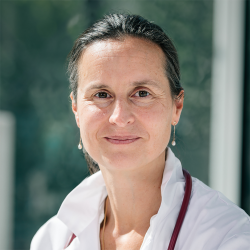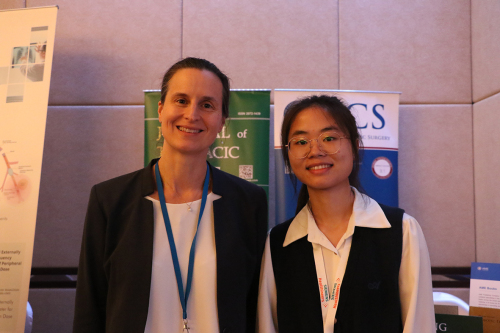Agathe Seguin-Givelet1, Lili Chen2
1Thoracic Department, Institut Montsouris, Institut du Thorax Curie Montsouris, Paris, France; 2SHC Editorial Office, AME Publishing Company
Editor’s note
The 2nd Bronchoscopic Ablation Summit (BAS 2023) hosted by the Chinese University of Hong Kong (CUHK) was held successfully in Hong Kong from October 26-27, 2023. Gathering experts from worldwide, the two-day summit presented the latest techniques in advanced navigation and robotic bronchoscopy, imaging and ablation technologies.
During the summit, Dr. Agathe Seguin-Givelet from the Institut Montsouris, France delivered interesting topics on “Institute of Thorax Curie-Montsouris Experience” and “Getting Bronchoscopic Ablation Program Started”, and also chaired the session on “Energy Source”. We are honored to invite Dr. Seguin-Givelet for a brief interview to share with us her perspectives on bronchoscopic therapy for the treatment of lung cancer (Video 1, Figure 1).
Figure 1 Picture with Dr. Seguin-Givelet (left)
Expert introduction
Agathe Seguin-Givelet (Figure 2) is the head of the thoracic department at Institute Mutualist Montsouris. Deeply involved in MIS with VATS and RATS programs, she has a major experience in segmentectomies thanks to the department which has the largest European experience in this field. She leads the IMM thoracic team to organize successful international sublobar conferences (2018, 2019, 2021, 2023, next 2025). She went on to do the first in the Europe (except UK) endobronchial microwave ablation of lung tumor in December 2022.

Figure 2 Dr. Seguin-Givelet
Interview
SHC: After more than 10 years as a thoracic and vascular surgeon at Avicenne Hospital, Public Health institution near Paris, you shifted your focus to thoracic surgery and mainly lung tumors. What is the reason that prompted you to make this decision?
Dr. Seguin-Givelet: Thoracic surgery is becoming more and more specialized and I wanted to focus more on lung cancer surgery. That is why I chose eight years ago to do only thoracic surgery and also to be more involved in more interventional pulmonology like broncoscopic ablation for lung cancer and metastatic disease.
SHC: Thank you for sharing your experience with bronchoscopic ablation at the Institute of Thorax Curie-Montsouris Experience in France, is there any unique treatment methods and techniques that you believe will contribute to the development of bronchoscopic ablation?
Dr. Seguin-Givelet: I really think that the bronchoscopic treatment will be part of the future for our patients. It will be complementary with other treatments like surgical resections. As we develop a more tailored surgery, we really need to be involved on bronchoscopy treatment. Besides microwave ablation, there are also other techniques such as electroporation, radiofrequency, and cryotherapy. There are a lot of treatments that could come by an end-bronchial way.
SHC: In the session on energy source, experts from all over the world discussed different tumor ablation modalities, including radiofrequency ablation, vapour ablation, microwave ablation, and cryoablation. When considering an ideal ablation energy source, what key characteristics or features are essential?
Dr. Seguin-Givelet: I think for the future the right ablation will be the one with good margins, with a very clear assessment during the procedures. It could be one of these three procedures but at that time it is difficult to assess that we obtain the result and it would be very necessary in the future. I think we still need more development and more control of the efficacy of the procedures at that time.
SHC: In your opinion, for the treatment of peripheral lung malignancies, which of these modalities do you believe is the most effective?
Dr. Seguin-Givelet: As a thoracic surgeon, I still think that the surgical therapy is the best offer for the patients, but there are some patients in who we need to spare some parenchyma or patients are not fit for the surgery. Ablation treatment could arrive as a second line of treatment and can be also in competition with the stereotactic body radiotherapy (SBRT).
SHC: We learnt that you went on to do the first in the Europe (except UK) endobronchial microwave ablation of lung tumor in December 2022. Would you like to share with us this experience? Based on your experience, could you share some advice with young surgeons on achieving excellence in bronchoscopic ablation procedures?
Dr. Seguin-Givelet: We have done the first French ablation treatment on December 2022. That was the biggest steps for us in our institution, and I really think that the thoracic surgeon and interventional pulmonology should be involved in these new treatments. That would probably be a new option for patients. My sharing experience is that you could be enthusiastic and you also need to be curious and to go and do immersive journey to see other experiments in other institutions and to bring what you think it is new option for your patients in your own country. That is what we have done.
SHC: In the final session of looking ahead in this summit, you shared important insights on getting the Bronchoscopic Ablation Program started. In your opinion, what are the most crucial factors to consider when initiating this program?
Dr. Seguin-Givelet: You need to know your navigation system. You need to have an equipment with a good imaging like cone beam computed tomography (CT). You also need to know how to treat the patient. It means that you need to be aware of your thermal therapy. We are working with our radiologists that are doing percutaneous microwave ablation. Also, you need to share your experience with others to improve together.

